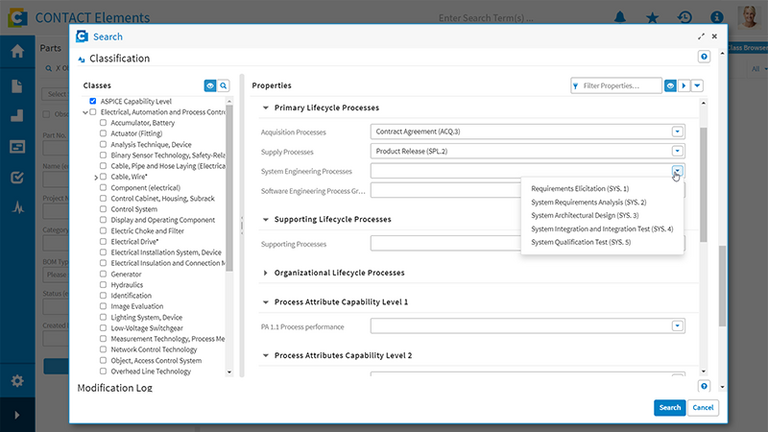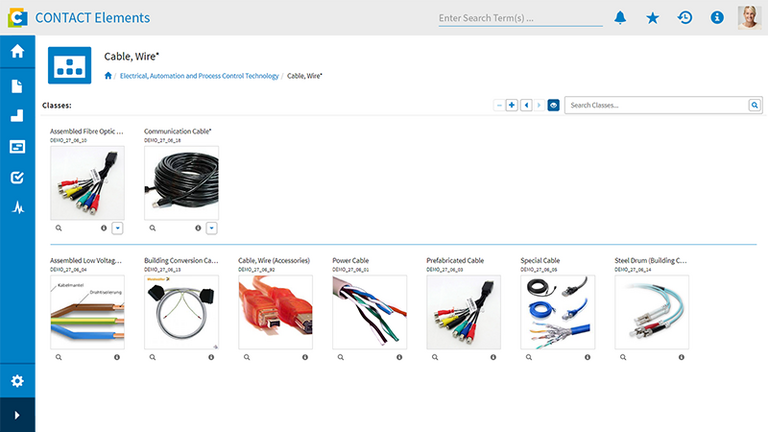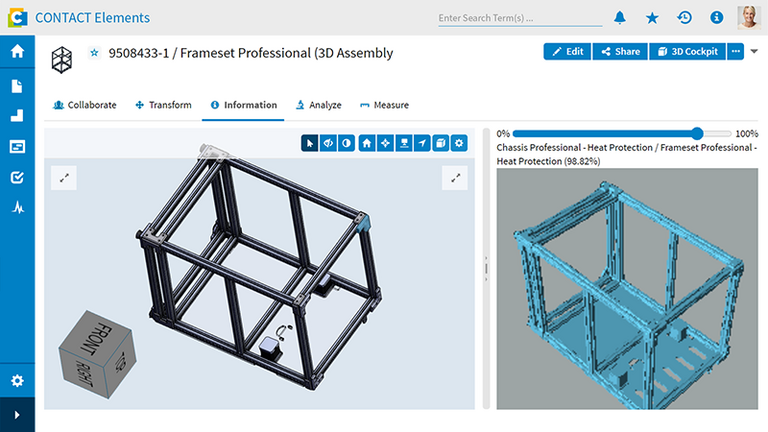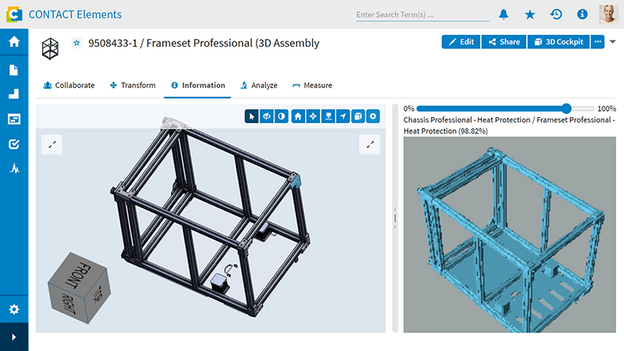Benefits
- Increase reuse and cut costs and parts diversity through parts classification
- Faster parts search results thanks to class lists of characteristics and visual navigation
- Effective search support for geometrically similar parts

Increase your reuse rate and reduce your costs and parts diversity

Standardization and the reuse of proven solutions offer a huge potential for cost savings in manufacturing companies. Proven standards include part classification according to ECLASS or by means of class lists of characteristics (CLC) according to DIN 4000/4001/4002. Map characteristics via functional group hierarchies in any width and depth and thus support the creation of a portfolio-oriented characteristics catalog. For example, structure your inventory according to functional, geometric and physical properties and thus ensure transparency in the parts master.
Parametrics allow you to derive parts directly from 3D models
What is more, your developers can make use of the parametric CAD integration to derive components directly from templates in the CAD system based on the characteristic values of classified articles taken from the 3D models. If a developer creates a new parts master record together with characteristics, then the associated 3D geometry and drawings are automatically available. Part Classification & Reuse provides you with the basis for reducing diversity in your parts inventory and achieve a high reuse level. You will speed up your development processes, improve your product quality and cut your procurement, administration and storage costs.
Increase your reuse rate and reduce your costs and parts diversity
Standardization and the reuse of proven solutions offer a huge potential for cost savings in manufacturing companies. Proven standards include part classification according to ECLASS or by means of class lists of characteristics (CLC) according to DIN 4000/4001/4002. Map characteristics via functional group hierarchies in any width and depth and thus support the creation of a portfolio-oriented characteristics catalog. For example, structure your inventory according to functional, geometric and physical properties and thus ensure transparency in the parts master.
Parametrics allow you to derive parts directly from 3D models
What is more, your developers can make use of the parametric CAD integration to derive components directly from templates in the CAD system based on the characteristic values of classified articles taken from the 3D models. If a developer creates a new parts master record together with characteristics, then the associated 3D geometry and drawings are automatically available. Part Classification & Reuse provides you with the basis for reducing diversity in your parts inventory and achieve a high reuse level. You will speed up your development processes, improve your product quality and cut your procurement, administration and storage costs.

Standardization and the reuse of proven solutions offer a huge potential for cost savings in manufacturing companies. Proven standards include part classification according to ECLASS or by means of class lists of characteristics (CLC) according to DIN 4000/4001/4002. Map characteristics via functional group hierarchies in any width and depth and thus support the creation of a portfolio-oriented characteristics catalog. For example, structure your inventory according to functional, geometric and physical properties and thus ensure transparency in the parts master.
Parametrics allow you to derive parts directly from 3D models
What is more, your developers can make use of the parametric CAD integration to derive components directly from templates in the CAD system based on the characteristic values of classified articles taken from the 3D models. If a developer creates a new parts master record together with characteristics, then the associated 3D geometry and drawings are automatically available. Part Classification & Reuse provides you with the basis for reducing diversity in your parts inventory and achieve a high reuse level. You will speed up your development processes, improve your product quality and cut your procurement, administration and storage costs.
Speed up your parts searches based on characteristics and visual navigation

With Part Classification & Reuse, you will dramatically accelerate your parts searches: Using characteristics group names, classification keys or the values of characteristics, your developers will find the parts they need quickly and easily. Searches involving metadata and full-text searches also run faster. A wide range of units of measurement and values can be used as parameters when creating new characteristics or performing characteristics-based searches. In addition, you can synchronize the classification information with ERP systems and seamlessly integrate leading standard parts systems such as CADenas and PARTsolutions.
Quickly navigate through parts inventory with visual Class Browser
The visual display of classifying data is another "parts search accelerator". As an alternative navigation and search option in addition to the conventional parts search, the Class Browser accelerates the identification of required parts by intuitively navigating visually through the parts inventory.
Speed up your parts searches based on characteristics and visual navigation
With Part Classification & Reuse, you will dramatically accelerate your parts searches: Using characteristics group names, classification keys or the values of characteristics, your developers will find the parts they need quickly and easily. Searches involving metadata and full-text searches also run faster. A wide range of units of measurement and values can be used as parameters when creating new characteristics or performing characteristics-based searches. In addition, you can synchronize the classification information with ERP systems and seamlessly integrate leading standard parts systems such as CADenas and PARTsolutions.
Quickly navigate through parts inventory with visual Class Browser
The visual display of classifying data is another "parts search accelerator". As an alternative navigation and search option in addition to the conventional parts search, the Class Browser accelerates the identification of required parts by intuitively navigating visually through the parts inventory.
With Part Classification & Reuse, you will dramatically accelerate your parts searches: Using characteristics group names, classification keys or the values of characteristics, your developers will find the parts they need quickly and easily. Searches involving metadata and full-text searches also run faster. A wide range of units of measurement and values can be used as parameters when creating new characteristics or performing characteristics-based searches. In addition, you can synchronize the classification information with ERP systems and seamlessly integrate leading standard parts systems such as CADenas and PARTsolutions.
Quickly navigate through parts inventory with visual Class Browser
The visual display of classifying data is another "parts search accelerator". As an alternative navigation and search option in addition to the conventional parts search, the Class Browser accelerates the identification of required parts by intuitively navigating visually through the parts inventory.
Provide effective support for geometric similarity searches

CONTACT's visualization solution 3D Connect supports searches for geometrically similar parts by means of extensions. The geometric similarity search incorporates established best-in-class technologies. This includes SIMILIA, for example, which offers a very powerful automated mechanism for classifying parts on the basis of heuristics. Another example is CADENAS. By integrating the standard parts library, CONTACT Elements makes it possible to use the similarity search directly from within the CAD system. The advantage here is the fact that the parts inventory is automatically synchronized in the PLM and standard parts system in the background, which means that it is irrelevant where a part was first registered.
Provide effective support for geometric similarity searches
CONTACT's visualization solution 3D Connect supports searches for geometrically similar parts by means of extensions. The geometric similarity search incorporates established best-in-class technologies. This includes SIMILIA, for example, which offers a very powerful automated mechanism for classifying parts on the basis of heuristics. Another example is CADENAS. By integrating the standard parts library, CONTACT Elements makes it possible to use the similarity search directly from within the CAD system. The advantage here is the fact that the parts inventory is automatically synchronized in the PLM and standard parts system in the background, which means that it is irrelevant where a part was first registered.

CONTACT's visualization solution 3D Connect supports searches for geometrically similar parts by means of extensions. The geometric similarity search incorporates established best-in-class technologies. This includes SIMILIA, for example, which offers a very powerful automated mechanism for classifying parts on the basis of heuristics. Another example is CADENAS. By integrating the standard parts library, CONTACT Elements makes it possible to use the similarity search directly from within the CAD system. The advantage here is the fact that the parts inventory is automatically synchronized in the PLM and standard parts system in the background, which means that it is irrelevant where a part was first registered.
Related Elements
Classify parts, documents and other objects
Improve the organization of your master data with an extremely powerful classification system
Speed up your development process and support innovative methods such as systems engineering
Use class lists of characteristics to reduce parts variety and costs and benefit from visual support when searching for part
Create product architectures and structures efficiently
- Develop requirements-oriented products
- Create mechatronic product structures for systems engineering
- Configure variants with 150% BOMs
- Manage BOMs and ensuring compliance
- Use reliable interfaces between development and production
Effective frontloading for variable product design
Determine the variability in product management and engineering
Define complete variant models quickly and easily
Supply the correct items, BOMs and model data automatically to downstream processes.
Further information
Would you like to find out more about this topic? Choose one of the following information offers.


